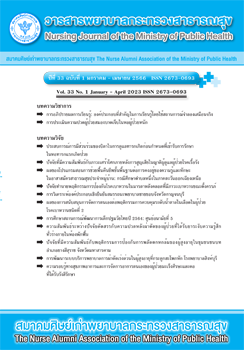Early Childhood Development in Thailand in 2021: Public Health Region 5
Main Article Content
Abstract
This descriptive study was conducted to examine factors associated with child development. The stratified sampling technique was employed to randomly choose 390 children, aged 9 months to 6 years, and their families Data were gathered through interviews, mother-and-child health handbooks, and examinations utilizing the Denver Developmental Screening Test II (Denver II). The content validity was .77, while the Cronbach’s alpha coefficient was .89. Data were collected from April to May 2021 and analyzed using descriptive statistics and multiple logistic regression. The results indicated that Thai childhood development in Public Health Region 5 had a rate of age-appropriate development of 73.10% and a rate of delayed development of 26.90%. The most delayed development was language, followed by social and self-help skills, as well as small and large muscle development. Maternal factors (educated and between 20 and 35 years old), environmental factors (breastfeeding and reading with children), and child factors (weight greater than 2,500 grams at birth, gender, iron supplementation, and no oral cavity issue) were found to significantly predict child development. It is suggested that the DSPM guides should be provided in a format that fits with societal change, such as YouTube, video, tiktok, etc., in order to evaluate and promote child development at an age-appropriate rate and it should be monitored every three months.
Article Details

This work is licensed under a Creative Commons Attribution-NonCommercial-NoDerivatives 4.0 International License.
บทความและรายงานวิจัยในวารสารพยาบาลกระทรวงสาธารณสุข เป็นความคิดเห็นของ ผู้เขียน มิใช่ของคณะผู้จัดทำ และมิใช่ความรับผิดชอบของสมาคมศิษย์เก่าพยาบาลกระทรวงสาธารณสุข ซึ่งสามารถนำไปอ้างอิงได้
References
The 20-Year National Strategic Plan (2017-2036) on Public Health. Strategy and Work Plans Division Office of the Permanent Secretary, Ministry of Public Health; Nonthaburi.2018.(in Thai)
Office of the National Economic and Social Development Council. National Economic and Social Development Plan, No.12, 2017–2021.Bangkok: Office of the National Economic and Social Development Council.2017.(in Thai)
World Health Organization. Developmental difficulties in early childhood: Prevention, early identification, assessment and intervention in low- and middle-income countries: a review. Child and adolescent health and development. Turkey: Turkey Country Office and CEECIS Regional Office. 2012.
Levy PS, Lemshow S. Sampling of populations: methods and applications. New York: John Wiley & Sone.2013.
Loe Sathienkit P. Situation of Thai early childhood development. Public Health Region 3 Chonburi, Department of Health Promotion.2015.(in Thai)
Pattanapongthorn J, Boonsuwan C, Thanacharoenwat N. Report of the study. Early Child Development in Thailand 2014. Office of Health Promotion, Department of Health.2015.(in Thai)
Pattanapongthorn J. Research report on factors affecting early childhood development in Thailand. No. 6, 2017, Office of Health Promotion, Department of Health.2018.
Anderson DR, Pempek TA. Television and very young children. American Behavioral Scientist 2015;48(5):505-22.
Kotchaphakdi N. Textbook of child development and behavior. For general practice Beyond Company Enterprise Co., Ltd. Bangkok.2011.(in Thai)
Authawee B, Phongphetdit B. Control and prevention of iron deficiency anemia in children aged 6 -12 months Nursing Journal of the Ministry of Public Health 2020;30(1):82-92.(in Thai)
Multimedia Anamai. Tales and IQ and EQ development (275). [Internet].2015[cited 21May2018]. Availablefrom:http://nctc.oncb.go.th/new/index.php?option=com_content&view=article&id=1054:2555-02-10-04-m-s&catid=173:-2554&Itemid=229. (in Thai)
Lozoff B, Jimenez E, Wolf AW. Long-term developmental outcome of infants with iron deficiency. N Eng J Med 1991;325:678-94.
Nutritional anemia. Report of a WHO scientific group. World Health Organ Tech Rep Ser.1968;405:5-37.
Chantrapanichkul P, Chawanpaiboon S. Adverse pregnancy outcomes in cases involving extremely young
maternal age. International Journal of Gynecology and Obstetrics2013;120(2):160-4.

